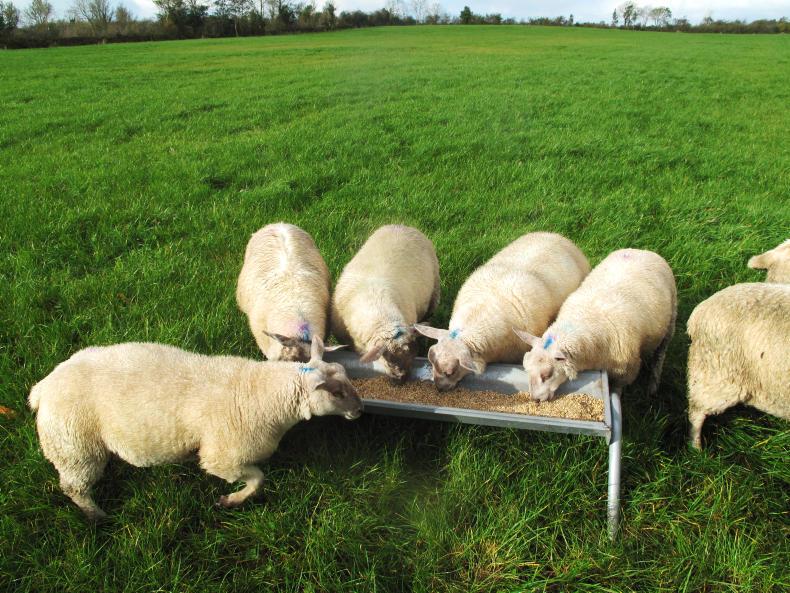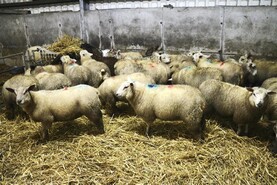A slow start to the year and difficult weather in many parts of the country for much of the summer has left many mid-season producers anywhere from two to four weeks behind normal drafting rates.
Finishing of lambs is being complicated by kill-out percentages running in many cases 1% to 3% behind normal, with factory personnel reporting a significant volume of lambs killing at fat scores of one and two.
There is massive variation across the country, with those worst affected farming on heavy soils or marginal lands receiving high levels of rainfall.
Daily liveweight performance is also very variable, ranging from lambs being on target and gaining 150g to 170g per day to lambs struggling to hit 70g to 100g per day. This is being influenced by the dry matter content of grass falling week-on-week and, as such, reducing the energy content or feeding value of grazed grass.
Maintaining performance
Where the feeding value of grass is falling, performance can be maintained by providing lambs with an extra supply of energy in the form of concentrate supplementation. This will also improve dry matter intake and help improve digestion and utilisation of grazed grass with a low dry matter content.
Where grass supplies are adequate, protein will not be a concern and feeding cereals such as rolled or whole barley or oats will help to significantly increase energy intake.
Some farmers are also purchasing ground maize at good value, but intake may be a concern until lambs become accustomed to the feed.
The economics of feeding are helped by targeting lambs that will deliver the best response. At present, many farmers report having lambs weighing 38kg to 45kg that are poorly fleshed. Feeding cereals at 0.5kg/head/day should be sufficient to achieve favourable levels of performance. This may need to be increased if grass supplies are depleting fast or grass quality is poor.
In such cases, it is important to balance the concentrate offered to prevent digestive upsets. A diet such as barley, beet pulp, soyabean or rapeseed meal works satisfactorily when feeding higher levels.
It is critical that minerals and vitamins are included at 2.5% where feeding higher levels, with indoor finishing diets formulated to promote water intake and reduce the incidence of urinary calculi.
Feeding ad-lib concentrates should be targeted to an even tighter specification of lamb and limited to a maximum of six to seven weeks, as feed costs can quickly accumulate.
Where high numbers are being fed and ground conditions are poor, lambs will benefit from housing and will achieve higher performance than those retained outdoors in poor conditions.
Indoor finishing
As is the case with supplementation at grass, the economics of indoor finishing is heavily influenced by the length of the feeding period and diet.
Teagasc has carried out extensive research in this area with three main finishing systems generally outlined as options – ad-lib concentrates and high levels of concentrate feeding and silage. Table 1 details the expected performance of lighter lambs weighing 33kg, previously published in an article by Teagasc sheep specialist Frank Hynes.
Similar levels of performance are attainable for heavier lambs, with lambs finished in recent years in the Teagasc Athenry demo flocks on a concentrate and high-quality silage diet and in trials carried out by Teagasc’s Tim Keady.
Performance will also be influenced by the type of lamb, with lambs that have undergone a setback or are stunted taking much longer to respond and start thriving.
It is important to note that where silage quality is lower than listed, the potential of the finishing system comes into question, with performance levels and the economics of finishing reducing quickly as silage quality approaches 70DMD.
In a situation like this where silage quality is variable or unknown, ad-lib concentrates is by far the most preferable finishing diet due to the high level of performance, better feed efficiency and higher kill-out percentage attainable.
Grassland management
Those farming on drier lands continue to experience high levels of grass growth. The challenge here is to maintain good-quality grass for lambs and ideally grazing swards of 7cm to 8cm in height.
Where swards have got ahead of lambs (10cm+), performance will be hit by forcing animals to graze these areas to a low sward height, especially where there is a high percentage of stem or lower quality material.
Where possible, lambs should be moved once they have grazed good-quality grass, with ewes on a maintenance diet later in the season used to graze out these paddocks.
Finish versus selling
With the store lamb trade also holding steady, the option of selling lambs as stores must also be considered when completing a finishing budget.
In many cases, it may be more economical to trade lambs, with demand holding firm due to good grass supplies present on many beef farms and competition from these buyers.
The decision to sell or finish on farm must also take into account current grass supplies and the feeding programme for ewes in the coming months.
Options for hill lambs
Finishing options for hill lambs have been extensively covered in recent years from information stemming from trials carried out by Michael Diskin and Noel Claffey in Teagasc Athenry.
Teagasc has also developed a calculator that allows farmers to quickly formulate finishing budgets for hill lambs. This can be accessed at www.teagasc.ie/sheep, while last year’s article on options for finishing hill lambs can be viewed online at www.farmersjournal.ie/sheep.






 This is a subscriber-only article
This is a subscriber-only article











SHARING OPTIONS: